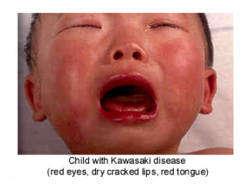|
|
Pathology definition - Kawasaki disease

Kawasaki disease
Kawasaki disease may present with signs and symptoms such as fever, erythema of the soles of the feet, erythema of the palms of the hands, cervical lymphadenopathy, mucocutaneous lesions of the oral mucosa, edematous hand, edematous feet and congested conjunctiva.
Kawasaki disease is due to dysregulation of the immunological system of the patient. Kawasaki disease may leaf to fatality due to its complication. The common complication of Kawasaki disease is coronary artery aneurysm. Ruptured of the coronary artery aneurysm may lead to death. Kawasaki disease is mostly affecting young children and infants.
Kawasaki disease may present with necrosis of the vascular wall ( small or medium sizes vessel as well as coronary arteries) and inflammation of the transmural region due to infiltration of the inflammatory agent.
Kawasaki disease is a self limited disease which maybe treated with aspirin and intravenous gammaglobulin.
References
1.Furusho, Kenshi, Hiroyuki Nakano, Keisuke Shinomiya, Tokio Tamura, Yutaka Manabe, Masaharu Kawarano, Kiyoshi Baba, et al. “HIGH-DOSE INTRAVENOUS GAMMAGLOBULIN FOR KAWASAKI DISEASE.” The Lancet 324, no. 8411 (November 10, 1984): 1055–1058. doi:10.1016/S0140-6736(84)91504-6.
2.Dajani, A. S., K. A. Taubert, M. A. Gerber, S. T. Shulman, P. Ferrieri, M. Freed, M. Takahashi, F. Z. Bierman, A. W. Karchmer, and W. Wilson. “Diagnosis and Therapy of Kawasaki Disease in Children.” Circulation 87, no. 5 (May 1, 1993): 1776–1780. doi:10.1161/01.CIR.87.5.1776.
Kawasaki disease may present with signs and symptoms such as fever, erythema of the soles of the feet, erythema of the palms of the hands, cervical lymphadenopathy, mucocutaneous lesions of the oral mucosa, edematous hand, edematous feet and congested conjunctiva.
Kawasaki disease is due to dysregulation of the immunological system of the patient. Kawasaki disease may leaf to fatality due to its complication. The common complication of Kawasaki disease is coronary artery aneurysm. Ruptured of the coronary artery aneurysm may lead to death. Kawasaki disease is mostly affecting young children and infants.
Kawasaki disease may present with necrosis of the vascular wall ( small or medium sizes vessel as well as coronary arteries) and inflammation of the transmural region due to infiltration of the inflammatory agent.
Kawasaki disease is a self limited disease which maybe treated with aspirin and intravenous gammaglobulin.
References
1.Furusho, Kenshi, Hiroyuki Nakano, Keisuke Shinomiya, Tokio Tamura, Yutaka Manabe, Masaharu Kawarano, Kiyoshi Baba, et al. “HIGH-DOSE INTRAVENOUS GAMMAGLOBULIN FOR KAWASAKI DISEASE.” The Lancet 324, no. 8411 (November 10, 1984): 1055–1058. doi:10.1016/S0140-6736(84)91504-6.
2.Dajani, A. S., K. A. Taubert, M. A. Gerber, S. T. Shulman, P. Ferrieri, M. Freed, M. Takahashi, F. Z. Bierman, A. W. Karchmer, and W. Wilson. “Diagnosis and Therapy of Kawasaki Disease in Children.” Circulation 87, no. 5 (May 1, 1993): 1776–1780. doi:10.1161/01.CIR.87.5.1776.
